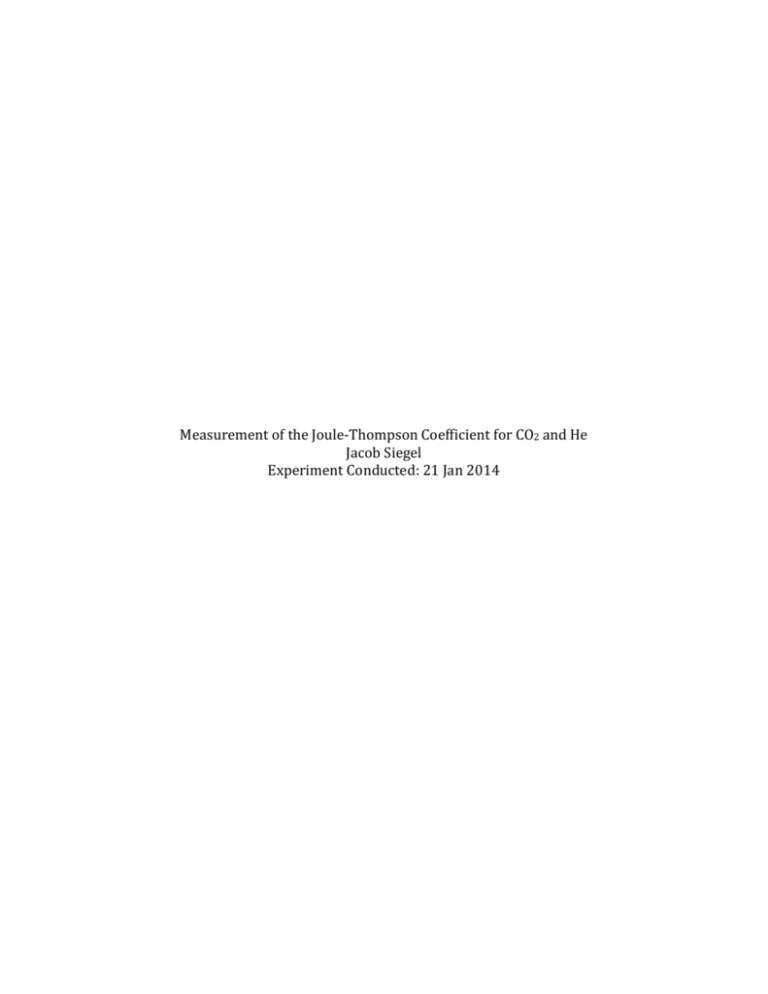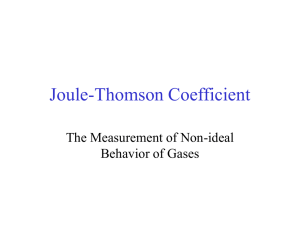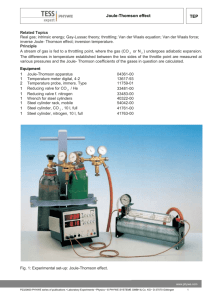
Measurement of the Joule-Thompson Coefficient for CO2 and He
Jacob Siegel
Experiment Conducted: 21 Jan 2014
Introduction:
The goal of this experiment was to experimentally determine the Joule-Thomson
coefficient for gaseous carbon dioxide (CO2) and Helium (He) at room temperature
and compare those values to the values predicted by the van der Waals equation of
state. In doing so, the physical properties of real gases can be observed. The JouleThomson coefficient represents the influence of intermolecular forces on real gases,
showing their dependence on both temperature and pressure, as demonstrated by
the procedures performed and resulting measurements in the experiment. The
intermolecular influences can be important when releasing gas from a pressurized
tank if the gas is sensitive to heat and at risk of exploding. The equation for the
Joule-Thomson coefficient is defined the partial differential of temperature over the
partial differential of pressure at constant enthalpy, or symbolically as:
T
T
JT lim .
P 0 P
H P H
The instruments used consist of an insulated and closed conduit with a porous plug,
pressurized tanks of He (g) and CO2 (g), a pressure gauge, an op amp and a
multimeter paired with a thermocouple.
Materials and Methods:
The multimeter was turned on and the gain on the op amp was set to 100. The
valve was opened on the large tank of He (g) and adjusted to deliver approximately
100 psi. Slowly, the pressure was then lowered to 90 psi, and then allowed to
equilibrate for 2 minutes, after which the pressure on the gauge (in psig) and the
voltage (in mV) were recorded. The pressure was then decreased over a 10-second
interval by 10 psi. The pressure and voltage were recorded after 1 minute. This 10
psi decrease was repeated until a final pressure of 10 psi was reached, recording the
pressure and voltage at every increment. The gas tank was then closed and the
experiment was repeated using CO2.
Results:
The values gathered and calculated for the releases of both compressed gases are
shown below, along with how they were reached, and with accompanying graphs
showing the relationship between ΔP and ΔT where the slope is equal to the JouleThomson coefficient.
To calculate the value of ΔP, the upstream pressure was subtracted from the
pressure after crossing the frit, in this case zero. This can be seen in the equations:
P = P2 - P1
and
P = - Pupstream
To calculate the adjusted voltage, the measured values were multiplied by 10,
accounting for the 1000x difference between milli- and microvolts then the 100x
amplifier on the thermocouple, shown by:
Vthermo = 10Vmulti
To calculate the value of ΔT, the adjusted voltage (Vthermo) was multiplied by the
conversion of voltage to temperature, shown below:
T
Vthermo
39 V/ C
To calculate the theoretical values of the Joule-Thomson coefficient by the van der
Waals equation of state, provided literature values were used for a, b, and the molar
heat capacity, and the equation used was:
1 2a
JT
b
C P ,m RT
Carbon dioxide (g)
Pupstream (psig)
ΔP (psi)
90
80
70
60
50
40
30
20
10
Vmulti (mV)
-90
-80
-70
-60
-50
-40
-30
-20
-10
-21.3
-18.3
-15.6
-13.2
-10.51
-7.8
-5.45
-3.33
-2
Vthermo (μV)
-213
-183
-156
-132
-105.1
-78
-54.5
-33.3
-20
ΔT (°C)
-5.461538462
-4.692307692
-4
-3.384615385
-2.694871795
-2
-1.397435897
-0.853846154
-0.512820513
Table 1 (Carbon dioxide results)- The values of upstream pressure, change in
pressure across the frit (ΔP), voltage measured (Vmulti), adjusted voltage (Vthermo),
and calculated change in temperature (ΔT) are shown for the carbon dioxide
release. The significant figures were ignored for change in temperature as to not
skew further calculations.
The experimental Joule-Thomson coefficient was converted from °C per psi to K per
MPa using the conversions of 14.7 psi = 1.013×105 Pa and 1 MPa= 106 Pa. The raw
value was 9.171174729 K/MPa. The value adjusted for significant figures is below:
Experimental Joule-Thomson coefficient (K/MPa)
Theoretical Joule-Thomson coefficient by vdW EOS (K/Mpa)
9.17
-1.08
Graph 1 (Carbon dioxide graph)- Shown above is the plot of the change in
temperature versus the change in pressure, the slope of which is equal to the JouleThomson coefficient in °C per psi. Once converted to K per MPa, the value was found
to be approximately 9.17 K/MPa. Error bars were included at 5% values in both
directions and the R2 value was 0.99424, indicating a close fit for the trendline.
The same calculations and conversions were used to calculate the values for the
helium section of the experiment.
Helium (g)
Pupstream (psig)
ΔP (psi)
90
80
70
60
50
40
30
20
10
Vmulti (mV)
-90
-80
-70
-60
-50
-40
-30
-20
-10
3.51
3.51
3.51
3.51
3.51
3.51
3.51
3.51
3.51
Vthermo (μV)
ΔT (°C)
35.1
35.1
35.1
35.1
35.1
35.1
35.1
35.1
35.1
Table 2 (Helium results)- The values of upstream pressure, change in pressure
across the frit (ΔP), voltage measured (Vmulti), adjusted voltage (Vthermo), and
calculated change in temperature (ΔT) are shown for the helium release. The
0.9
0.9
0.9
0.9
0.9
0.9
0.9
0.9
0.9
significant figures were ignored for change in temperature as to not skew further
calculations.
The raw value of the Joule-Thomson coefficient for helium was -1.16091 x 10-15
K/MPa. The value adjusted for significant figures is below:
Experimental Joule-Thomson coefficient (K/MPa)
Theoretical Joule-Thomson coefficient by vdW EOS (K/Mpa)
-1.16 x 10-15
-1.14
Graph 2 (Helium results)- Shown above is the plot of the change in temperature
versus the change in pressure, the slope of which is equal to the Joule-Thomson
coefficient in °C per psi. Once converted to K per MPa, the value was found to be
approximately -1.16 x 10-15 K/MPa. Error bars were included at 5% values in both
directions and the R2 value could not be found, likely due to there being no
significant change in the y-value.
Discussion:
For the carbon dioxide portion of the experiment, the experimentally measured
Joule-Thomson coefficient was found to be approximately 9.17 K/MPa. This is fairly
close to the literature value of 10.9 K/MPa, with a percent error of about 16%. This
positive value for the coefficient indicates that for carbon dioxide, at room
temperature, attractive intermolecular forces dominate. This means that increasing
the pressure of the gas decreases the intermolecular distance and increases
intermolecular attractions. Thus, when releasing this gas, heat is consumed. The
coefficient as determined by the van der Waals equation of state (-1.08 K/MPa)
provides a very skewed answer, actually of the opposite sign, showing that
intermolecular forces are not as accounted for.
For the helium portion of the experiment, the experimentally measured JouleThomson coefficient was found to be approximately -1.16 x 10-15 K/MPa. This is not
too close to the literature value of -0.62 K/MPa, with a percent error of almost
100%. This can be almost expected though because the coefficient for helium is very
small and difficult to measure with instruments that are not very sensitive and
conditions that are not perfectly constant. This negative value for the coefficient
indicates that for helium, at room temperature, repulsive intermolecular forces
dominate. This means that increasing the pressure of the gas decreases the
intermolecular distance but now increases intermolecular repulsions. Thus, when
releasing this gas, heat is released. The coefficient as determined by the van der
Waals equation of state (-1.14 K/MPa) came out to be fairly close to the literature
value. This might be closer than that for carbon dioxide because the coefficient is so
small that a large margin of error is harder to achieve.
References:
1. DiMilla, P. Lab 2- Measurement of the Joule-Thomson Coefficient.
2. Engel, T.; Reid, P. Physical Chemistry, 2nd ed.; Pearson Prentice Hall: Boston,
2010.










